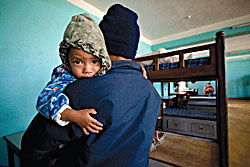|
|
Setting up an orphanage is a popular activity in Nepal among Western NGOs. There are now over a thousand orphanages in the country, and over 400 in the Kathmandu Valley. If each of them houses 30-40 children then in the valley alone around 15,000 children must live in such institutions.
Only a small portion of these children are really orphans. A USAID study among 350 'orphanages' in Nepal showed that only 20 percent of the 8,821 children surveyed had no parents while over 50 percent still had both parents. Many apparent orphans live on the street because their parents cannot afford to feed them properly, but NGOs should question if these homes really contribute to reducing poverty.
'Orphans' become adults
It seems a noble venture to bring poor street children to a children's home, but is it really an advantage for them to live there in the long run? They grow up without family ties or knowledge of their own caste/ethnic background, both of which are important social nets in Nepal, and come eighteen they are left to fend for themselves. There has not been much research into how well young adults can cope with this situation, but there is a high risk that they will have difficulty sustaining themselves and have a higher risk of suffering from identity crisis and behavioural problems than those brought up in a family and community environment.
Donations
Typical costs for food, lodging, clothing and education for an 'orphan' are at least Rs 3,000 per child per month, and land and construction prices in Kathmandu are also considerable. These costs are met by donors who want to contribute to poverty reduction, but children's homes will never ultimately bring about poverty reduction because they will never become self-sustainable.
Many village people want their children in children's homes as there they will get a chance to go to a good school, but instead of bringing children to a school far away from their village, NGOs could more efficiently invest in improving rural education. With an investment of Rs 100,000 per year for extra teachers at a local school all children in the village would benefit, while this amount only covers the expenses of two children in a children's home.
From business to criminal activities
For some Nepalis, running an orphanage is a type of business. Some children are bought from their families for a few thousand rupees and then sold at higher rates to an orphanage. Illegal adoption is another profitable form of trade, and some foreigners have been found paying thousands of euros to children's homes to adopt an 'orphan'. Financial abuse by the management of children's homes is widespread. For instance, last year a Dutch family lost thousands of euros when the director of Ganjala Children Home ran away with their donation money. Despite complaints lodged with the Social Welfare Council and Children's Welfare Board, the home was reregistered as \'Peace and Beautiful\' and continues to exploit well-meaning sponsors.
Some orphanages serve as cover-ups for even worse practices. Last year, a Dutch orphanage director was jailed after it was found that he sexually abused almost all children in his home. Paedophilia is a very serious issue that the Nepali government needs to address by implementing strict rules and improved monitoring.
Responsibility of donors
Who is responsible if an orphanage fails? Who will be held responsible if the children are abused, or end up on the street when the orphanage goes bankrupt? NGOs and their donors have a moral responsibility for the spending of their donations. If relatives are too poor to feed or educate the kids, donors should question whether placing the child in an orphanage is the best solution. Contributing to support the family - not by giving cash, but by providing means to generate income - can help it to afford to feed all its members and send the children to school. The money spent on one child in an orphanage per year (400-750 euro) is enough to support several families in this way.
Having some orphanages to cater for abandoned children is helpful, but 1,000 is really too many. Those who want to help Nepal should think of the long term effects of a project: for them it is a satisfying hobby, but for the beneficiaries it determines their future. The best projects address the causes of a problem, and aim at self-sustainability. Only then can they truly help to break the vicious circle of poverty.
Wilko Verbakel and Susan van Klaveren are board members of a Dutch NGO, the International Council for Friends Of Nepal (ICFON). More information, and an extended version of the article can be found on www.icfon.nl.



